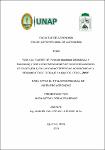| dc.contributor.advisor | Avila Fucos, Manuel Calixto | |
| dc.contributor.author | Coral Zambrano, Jhon Antony | |
| dc.date.accessioned | 2023-10-20T15:24:46Z | |
| dc.date.available | 2023-10-20T15:24:46Z | |
| dc.date.issued | 2021 | |
| dc.identifier.other | 633.2 C 2021 | |
| dc.identifier.uri | https://hdl.handle.net/20.500.12737/9410 | |
| dc.description.abstract | The research work was carried out at the National University of the Peruvian Amazon at the Faculty of Agronomy in the Beef Project in the Fundo de Zungarococha, entitled Two cultivars of Panicum maximum (mombasa and tanzania) and two concentrations of effective microorganisms (em-1) in the agronomic characteristics and forage yield in iquitos, peru - 2019. The evaluations were carried out at the tenth week after sowing with vegetative seed (bushes), in plots of 3 mx 1.2 m (3.6 m2) and an experimental area of 141.1 m2. With a Complete Random Block Design (DBCA), with a factorial of 2 x 2 with four treatments and four repetitions, the treatments under study were: T1 (Tanzania culture with a concentration of 10% of EM - 1), T2 ( Tanzania culture with a concentration of 20% of EM-1), T3 (Mombasa culture with a concentration of 10% of EM-1) and T4 (Mombasa culture with a concentration of 20% of EM-1), obtaining the following results : The T2 treatment (cultivation of Tanzania with 20% of EM - 1), occupied in the agronomic characteristics and yield the best results, under the agroclimatic conditions of the area. With the concentration of 20% of EM-1, the cultivar Tanzania achieved the best results in agronomic characteristics such as plant height (m), green matter (kg / m2), dry matter (kg / m2), plant cover (%). The Cultivar Mombasa is lower in all the variables studied with the two concentrations of effective Microorganisms (EM-1), likewise it does not present an interaction. Regarding the yield of green matter per hectare, it is concluded that; cultivating Tanzania with the application of EM-1 at 20% concentration, achieved the best result with an average of 25925.00 kg / ha, beating Mombasa, who obtained an average of 20075.00 kg / ha, with the same concentration of EM-1, and at the same evaluation time. According to what was found in this work, Panicum maximum (Tanzania and Mombasa), are pastures that provide a large amount of green forage for feeding polygastric or ruminant animals. | en_US |
| dc.description.abstract | El trabajo de investigación se realizó en la Universidad Nacional de la Amazonia Peruana en la Facultad de Agronomía en el Proyecto Vacunos en el Fundo de Zungarococha, titulado Dos cultivares de Panicum maximum (mombasa y tanzania) y dos concentraciones de microorganismos eficaces (em-1) en las características agronomicas y rendimiento de forraje en Iquitos, Perú – 2019. Las evaluaciones fueron realizadas a la décima semana después de la siembra con semilla vegetativa (matas), en parcelas de 3 m x 1.2 m (3.6 m2) y un área experimental de 141.1 m2. Con un Diseño de Bloques Completo al Azar (D.B.C.A), con una factorial de 2 x 2 con cuatro tratamientos y cuatro repeticiones, los tratamientos en estudio fueron: T1 (cultivo Tanzania con una concentración del 10% de EM – 1), T2 (cultivo Tanzania con una concentración del 20% de EM – 1), T3 (cultivo Mombasa con una concentración del 10% de EM – 1) y T4 (cultivo Mombasa con una concentración del 20% de EM – 1), obteniendo los siguientes resultados: El tratamiento T2 (cultivo de Tanzania con 20% de EM – 1), ocuparon en las características agronómicas y rendimiento los mejores resultados, bajo las las condiciones agroclimáticos de la zona. Con la concentración de 20 % de EM-1, el Cultivar Tanzania logró los mejores resultados en las características agronómicas como son altura de planta (m), materia verde (kg/m2), materia seca (kg/m2), cobertura de planta (%). El Cultivar Mombasa, se muestra inferior en todas las variables estudiadas con las dos concentraciones de Microorganismos eficaces (EM-1), así mismo no presenta interacción. En cuanto al rendimiento de materia verde por hectárea se concluye que; el cultivar Tanzania con la aplicación de EM-1 al 20 % de concentración, logro el mejor resultado con promedio de 25925.00 kg/ha, superando a Mombasa que obtuvo un promedio de 20075.00 kg/ha, con la misma concentración de EM-1, y en el mismo tiempo de evaluación. De acuerdo con lo encontrado en este trabajo, Panicum máximum (Tanzania y Mombasa), son pastos que proporcionan gran cantidad de forraje verde para para la alimentacion de animales poligastricos o rumiantes. | es_PE |
| dc.format | application/pdf | es_PE |
| dc.language.iso | spa | es_PE |
| dc.publisher | Universidad Nacional de la Amazonía Peruana | es_PE |
| dc.rights | info:eu-repo/semantics/openAccess | * |
| dc.rights.uri | https://creativecommons.org/licenses/by/4.0/ | * |
| dc.subject | Características agronómicas | es_PE |
| dc.subject | Rendimiento del forraje | es_PE |
| dc.subject | Microorganismos | es_PE |
| dc.subject | Concentración | es_PE |
| dc.subject | Tanzania | es_PE |
| dc.subject | Mombasa | es_PE |
| dc.subject | Panicum maximum | es_PE |
| dc.title | Dos cultivares de Panicum maximum (mombasa y tanzania) y dos concentraciones de microorganismos eficaces (em-1) en las características agronómicas y rendimiento de forraje en Iquitos, Perú – 2019 | es_PE |
| dc.type | info:eu-repo/semantics/bachelorThesis | es_PE |
| thesis.degree.discipline | Agronomía | es_PE |
| thesis.degree.grantor | Universidad Nacional de la Amazonía Peruana. Facultad de Agronomía | es_PE |
| thesis.degree.name | Ingeniero(a) Agrónomo | es_PE |
| dc.subject.ocde | https://purl.org/pe-repo/ocde/ford#4.01.06 | es_PE |
| renati.author.dni | 75822028 | |
| renati.advisor.orcid | https://orcid.org/0000-0002-5390-966X | |
| renati.advisor.dni | 05327621 | |
| renati.type | https://purl.org/pe-repo/renati/type#tesis | es_PE |
| renati.discipline | 811036 | es_PE |
| renati.level | https://purl.org/pe-repo/renati/level#tituloProfesional | es_PE |
| renati.juror | Ramirez Chung, Jose Francisco | |
| renati.juror | Chavez Vasquez, Rafael | |
| renati.juror | Villacres Vallejo, Jorge Ysaac | |
| dc.publisher.country | PE | es_PE |





